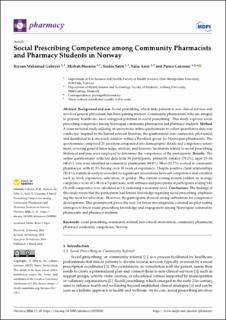| dc.description.abstract | Background and aim: Social prescribing, which links patients to non-clinical services and
involves general physicians, has been gaining traction. Community pharmacists, who are integral
to primary healthcare, have untapped potential in social prescribing. This study explores social
prescribing competence among Norwegian community pharmacists and pharmacy students. Method:
A cross-sectional study utilizing an anonymous online questionnaire to collect quantitative data was
conducted. Inspired by the limited relevant literature, the questionnaire was constructed, pilot-tested,
and distributed in a one-week window within a Facebook group for Norwegian pharmacists. The
questionnaire comprised 23 questions categorized into demographic details and competence assess-
ment, covering general knowledge, attitude, and barriers/facilitators related to social prescribing.
Statistical analyses were employed to determine the competence of the participants. Results: The
online questionnaire collected data from 96 participants, primarily females (79.2%), aged 25–34
(40.6%), who were identified as community pharmacists (49.0%). Most (91.7%) worked in community
pharmacies, with 31.3% having over 10 years of experience. Despite positive client relationships
(93.8%), statistical analysis revealed no significant associations between competence and variables
such as work experience, education, or gender. The custom scoring system yielded an average
competence score of 1.98 on a 5-point scale, with attitudes and perceptions of participants scoring 3.82.
Overall competence was calculated at 3.4, indicating a moderate level. Conclusions: The findings of
this study reveal that the participants had limited knowledge regarding social prescribing, emphasiz-
ing the need for education. However, the participants showed strong enthusiasm for competence
development. This groundwork paves the way for future investigations centered on pilot-testing
strategies to boost social prescribing knowledge and engagement among Norwegian community
pharmacists and pharmacy students. | en_US |

